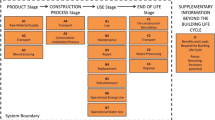Abstract
This is the final paper of a series of three on the use of LCA in a strategic EIA made for the second Dutch National Hazardous Waste Management Plan (NHWMP). A comparison of two options for paint packaging waste separation is given: cryogenic versus shredder-flush separation. The high liquid nitrogen use in the cryogenic process, and particularly the energy needed to produce it, tends to make the cryogenic process environmentally less favourable. As for the other technology comparisons in the EIA, no particular problems arose. The EIA passed its peer review successfully and survived a very extensive public review procedure, in spite of the fact that it supported decisions involving very high financial stakes. Several lessons can be learned from this experience. First, LCA is a suitable tool in strategic EIAs on waste. Second, time-consuming, interactive public participation in LCA is no precondition for public acceptance — a process ofstakeholder deliberation that ensures that the practitioner knows the relevant perspective is enough. Third, high decision stakes do not automatically demand very extensive LCA work. Our experience shows that LCAs just above screening level can provide robust support to decisions involving dozens of million Euros. More extensive work would not have lead to more specified preferences. Rather, in our view, being well aware of the key discussion points in advance which are seen as relevant for the comparison by stakeholders, and having good insight in the related inherent limits of LCA, is the key to optimal decision support with LCA.
Similar content being viewed by others
References
AfvalOverlegOrgaan (AOO, 1995a): Milieu-effectrapport Tienjarenprogramma Afvalstoffen 1995–2005[EIA Ten-year Programme Waste Management 199S-2005], AOO, the Netherlands
ATM (1993): MER Afvalstoffen Terminal Moerdijk[EIA Waste Terminal Moerdijk], ATM, Moerdijk, the Netherlands
ATF (1993): MER verwerking chemisch afval ATF[EIA treatment of hazardous waste ATF], ATF, Drachten, the Netherlands
Bez, J., Heyde, M.; Goldhan, G. (1998): Waste Treatment in Product Specific Life Cycle Inventories: An Approach of Material-Related Modelling. Part II: Sanitary Landfill. Int. J. LCA 3 (2) 100
EIA Commission (1996): Toetsingsadvies Milieu-effectrapport Meerjarenplan Gevaarlijk Afval 1997–2007[Peer review advice EIA NHWMP 1997–2007], EIA Commission, Utrecht, the Netherlands
Finnveden, G.;Huppes, G. (1995): Life Cycle Assessment and Treatment of Solid Waste. AFR-Report 98, AFR/Swedish EPA, Stockholm, Sweden
Frischknecht, R. (ed.) (1994): Oekoinventare für Energiesysteme, ETH/PSI Villingen, ENET, Bern, Switzerland
Hejjungs, R.,Guinée, J.B.;Huppes, G.;Lankreijer, R.M.;Udo de Haes, H.A.;Wegener Sleeswijk, A.;Ansems, A.A.M.;Eggels, P.G.;van Duin; R.;de Goede, H.P. (1992): Environmental Life-cycle Assessment of Products, Guide and backgrounds, CML/TNO/B&G, Leiden, Holland
Hoogers (1995): MER Uitbreiding vewerking chemisch afval Hoogers[EIA extension treatment of hazardous waste Hoogers], Hoogers B.V., Geldrop, the Netherlands
InterChem (1994): MER verwerking verfresten e.a. bij InterChem/Exachem[EIA treatment of paint residues c.a. at InterChem/Exachem], InterChem, Beuningen, the Netherlands
Kremer, K.;Goldhan, G.;Heyde, M. (1998): LCI Method of Waste Treatment. An Approach of Material-Related Modelling. Part I: Incineration. Int. J. LCA 3 (1) 47
Leto (1996): Personal communication with Leto, Wierden, the Netherlands
Nielsen, P.H.;Hauschild, M. (1998a): Product Specific Emissions from Municipal Solid Waste Landfills Part I: Landfill Model. Int. J. LCA 3 (3) 158
Nielsen, P.H.;Exner, S.;Jørgensen, A.-M.;Hauschild, M. (1998b): Product Specific Emissions from Municipal Solid Waste Landfills Part II: Presentation and Verification of the Computer Tool LCA-LAND. Int. J. LCA 3 (4) 225
Smeets, E.W.G.;Tukker, A. (1995): Gebruikte chemicalienverpakkingen II[Spent packaging of chemical substances II]. Report 95/.., TNO-STB, Apeldoorn, the Netherland
Tukker, A.;van Rijn, H.T.U;Uyting, F.;Veeken, J. (with support of: M.M.A. Alkemade, G. Annokkée, W. Hesseling, J.I.A. Koene, E. Mulder and E.R.W. Smeets) (1996): Milieu-effectrapport Meerjarenplan Gevaarlijke Afvalstoffen 1997–2007[Environmental Impact Assessment Multi-year Hazardous Waste Management Plan 1997–2007]. Published by the Ministry of Environment and IPO, the Hague, the Netherlands, 400 pp.
Tukker, A. (1998): Life Cycle Impact Assessment of Toxic Releases. Practical Experiences — Arguments for a Reductionistic Approach? Int. J. LCA 3 (5) 246
Tukker, A. (1999): Frames in the Toxicity Controversy. Risk Assessment and Policy Analysis Related to the Dutch Chlorine Debate and Swedish PVC Debate. Kluwer Academic Publishers, Dordrecht/Boston/London
Tukker, A.;Simons, L. (forthcoming): Emissieprofielen verwijderingstechnologieën gevaarlijk afval.[Emission Profiles Treatment Technologies for Hazardous Waste], Draft report for the Dutch Environment Ministry, TNO-STB, Delft, the Netherlands
UNCED (United Nations Conference on Environment and Development, 1992): Agenda 21: the Declaration of Rio, Dutch translation, Ministry of VROM, the Hague, Holland
VROM (1993): Gebruikte chemicalienverpakkingen[Spent packaging of chemicals]. Waste management series 1993/8, Ministry of Environment, the Hague, the Netherlands (written by A.I.G. Roiackers and A. Tukker of TNO-SCMO)
VROM/IPO (1997a): Nota van Aanpassing Meerjarenplan gevaarlijke afvalstoffen II[White paper adaptation [of the proposed] Multi-year plan hazardous waste II], Ministry of Environment and the Interprovincial Union, the Hague, the Netherlands
VROM/IPO (1997b): Meerjarenplan gevaarlijke afvalstoffen 1997–2007[Multi-year plan hazardous waste 1997–2007], Ministry of Environment and the Interprovincial Union, the Hague, the Netherlands
White, P.R.;Franke, M.;Hindle, P. (1995): Integrated Solid Waste Management: A Life Cycle Inventory. Blackie Academic and Professional
Author information
Authors and Affiliations
Corresponding author
Rights and permissions
About this article
Cite this article
Tukker, A. Life Cycle Assessments for Waste, Part III: The Case of Paint Packaging Separation and General Conclusions. Int. J. LCA 5, 105–112 (2000). https://doi.org/10.1007/BF02979732
Received:
Accepted:
Issue Date:
DOI: https://doi.org/10.1007/BF02979732




